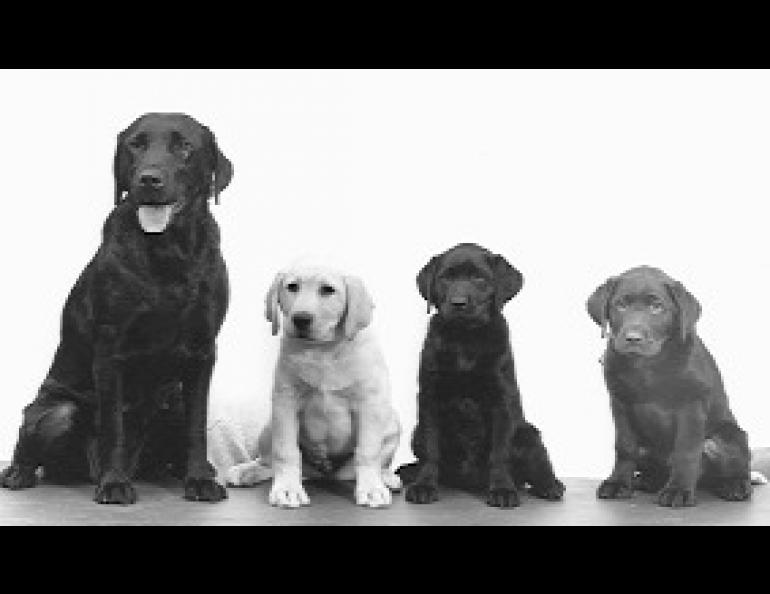
What Color is that Puppy in the Window?
Two black Labs are mated, and nine weeks later the puppies arrive: some blacks, of course, but some chocolates and yellows as well. Has something gone wrong? No, the litter is merely demonstrating Mendel's laws in action.
Gregor Mendel was an Austrian monk of the nineteenth century who, as a result of experiments in cross-breeding plants in his monastery garden, formulated the laws of heredity now known by his name. In modern terms, these laws state that every hereditary characteristic is controlled by a pair of genes in each individual. During reproduction, each parent provides just one gene for each character to the offspring, and which of the parent's pair is passed on is a random process. In some cases, there are several different variants of the gene for a particular trait. If both genes in an individual are of the same form, the individual will show the characteristic determined by that form of the genes. If the two genes in a pair differ, one may dominate over the other, and the individual will appear as if both its genes for the trait are the dominant gene.
Our Labrador Retriever litter illustrates the effects of genes for two different traits. One of these traits is thought to concern the protein that makes up the dark pigment granules in the dog's hair. If these granules are large and heavily pigmented, dark pigment appears black. If a different form of the protein is the only one that can be made, dark pigment occurs in smaller granules and appears chocolate brown -- not only in the hair coat, but in skin and eyes as well. If both kinds of genes are present, the black pigment will dominate and the dog appears black, but is able to pass the chocolate gene on to its puppies. The appearance of chocolate puppies in the litter is proof that both parents were carrying the chocolate gene, even though they appeared to be black.
The yellow puppies are due to a different pair of genes. Dogs, like most mammals, are able to produce a red-yellow pigment, phaeomelanin, as well as the dark pigment, eumelanin. In black and chocolate animals, only the dark pigment is produced. However, there is another pair of genes which determines whether the red-yellow or the dark pigment colors the hair coat. (The skin and eyes produce dark pigment in any case.) In this case, the gene for determining dark pigment in the coat is dominant over the gene for a red-yellow coat. So, a dog with one gene for dark pigment and one for red-yellow pigment will appear to be black or chocolate, depending on what genes are present to control black or chocolate color. Again, each of the parents of a litter which produces yellow puppies must have at least one gene for red-yellow pigment, so we know that the black parents of our mixed litter must each have had one gene for dark pigment and one for red-yellow pigment.
Note that if both parents are yellow then neither can carry the gene for dark pigment, so none of their puppies will be dark. They may, however, vary in their nose and eye color, which is dependent on what genes are present controlling black or chocolate pigment. A yellow puppy with one or both of these genes producing black will have dark skin pigment and fairly dark eyes. If the puppy has both genes for chocolate, however, the nose will be chocolate and the eyes lighter than normal.
Just to complicate things, yellow dogs in other breeds may not be due to the same genetic mechanism as that which controls yellow color in Labradors. Yellow or tan Collies and Boxers, for instance, are due to a group of genes which allows both black and yellow to get into the hair coat, but differs in where on the dog black and yellow occur. A yellow (technically, sable) Collie mated to a yellow Labrador would produce a litter of black puppies!
Many traits in dogs, and other mammals as well, are controlled by the interaction of many different pairs of genes. The kind of inheritance described above is an oversimplification for such complex traits as the shape of a nose or proneness to heart attacks. But the same heredity processes are still at work, in mice and men as well as in dogs, even though we do not fully understand all the genes involved.
Related articles are available on banded (agouti) hair , dilution genes , Siamese coloring in cats , and white spotting in domesticated animal.





